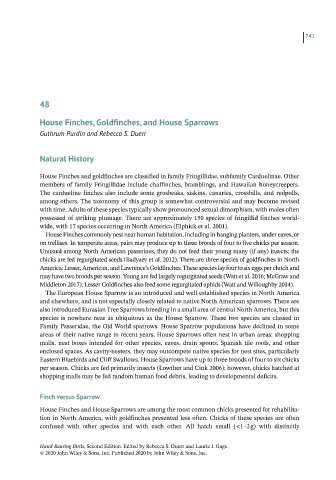Page 739 - Hand rearing birds second
P. 739
741
48
House Finches, Goldfinches, and House Sparrows
Guthrum Purdin and Rebecca S. Duerr
Natural History
House Finches and goldfinches are classified in family Fringillidae, subfamily Carduelinae. Other
members of family Fringillidae include chaffinches, bramblings, and Hawaiian honeycreepers.
The cardueline finches also include some grosbeaks, siskins, canaries, crossbills, and redpolls,
among others. The taxonomy of this group is somewhat controversial and may become revised
with time. Adults of these species typically show pronounced sexual dimorphism, with males often
possessed of striking plumage. There are approximately 150 species of fringillid finches world-
wide, with 17 species occurring in North America (Elphick et al. 2001).
House Finches commonly nest near human habitation, including in hanging planters, under eaves, or
on trellises. In temperate areas, pairs may produce up to three broods of four to five chicks per season.
Unusual among North American passerines, they do not feed their young many (if any) insects; the
chicks are fed regurgitated seeds (Badyaev et al. 2012). There are three species of goldfinches in North
America: Lesser, American, and Lawrence’s Goldfinches. These species lay four to six eggs per clutch and
may have two broods per season. Young are fed largely regurgitated seeds (Watt et al. 2016; McGraw and
Middleton 2017); Lesser Goldfinches also feed some regurgitated aphids (Watt and Willoughby 2014).
The European House Sparrow is an introduced and well‐established species in North America
and elsewhere, and is not especially closely related to native North American sparrows. There are
also introduced Eurasian Tree Sparrows breeding in a small area of central North America, but this
species is nowhere near as ubiquitous as the House Sparrow. These two species are classed in
Family Passeridae, the Old World sparrows. House Sparrow populations have declined in some
areas of their native range in recent years. House Sparrows often nest in urban areas: shopping
malls, nest boxes intended for other species, eaves, drain spouts, Spanish tile roofs, and other
enclosed spaces. As cavity‐nesters, they may outcompete native species for nest sites, particularly
Eastern Bluebirds and Cliff Swallows. House Sparrows have up to three broods of four to six chicks
per season. Chicks are fed primarily insects (Lowther and Cink 2006); however, chicks hatched at
shopping malls may be fed random human food debris, leading to developmental deficits.
Finch versus Sparrow
House Finches and House Sparrows are among the most common chicks presented for rehabilita-
tion in North America, with goldfinches presented less often. Chicks of these species are often
confused with other species and with each other. All hatch small (<1–2 g) with distinctly
Hand-Rearing Birds, Second Edition. Edited by Rebecca S. Duerr and Laurie J. Gage.
© 2020 John Wiley & Sons, Inc. Published 2020 by John Wiley & Sons, Inc.

